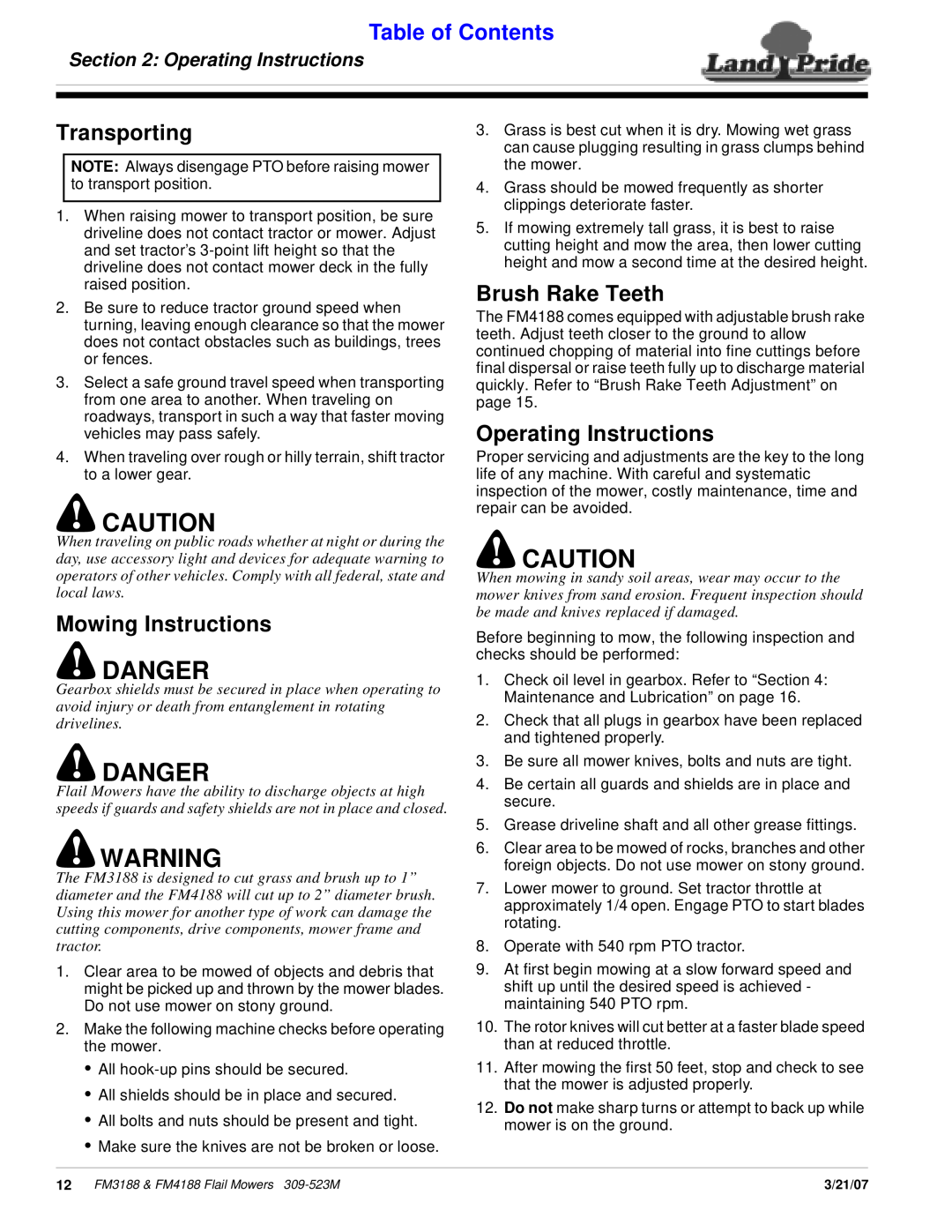
Table of Contents
Section 2: Operating Instructions
Transporting
NOTE: Always disengage PTO before raising mower to transport position.
1.When raising mower to transport position, be sure driveline does not contact tractor or mower. Adjust and set tractor’s
2.Be sure to reduce tractor ground speed when turning, leaving enough clearance so that the mower does not contact obstacles such as buildings, trees or fences.
3.Select a safe ground travel speed when transporting from one area to another. When traveling on roadways, transport in such a way that faster moving vehicles may pass safely.
4.When traveling over rough or hilly terrain, shift tractor to a lower gear.
!CAUTION
3.Grass is best cut when it is dry. Mowing wet grass can cause plugging resulting in grass clumps behind the mower.
4.Grass should be mowed frequently as shorter clippings deteriorate faster.
5.If mowing extremely tall grass, it is best to raise cutting height and mow the area, then lower cutting height and mow a second time at the desired height.
Brush Rake Teeth
The FM4188 comes equipped with adjustable brush rake teeth. Adjust teeth closer to the ground to allow continued chopping of material into fine cuttings before final dispersal or raise teeth fully up to discharge material quickly. Refer to “Brush Rake Teeth Adjustment” on page 15.
Operating Instructions
Proper servicing and adjustments are the key to the long life of any machine. With careful and systematic inspection of the mower, costly maintenance, time and repair can be avoided.
When traveling on public roads whether at night or during the day, use accessory light and devices for adequate warning to operators of other vehicles. Comply with all federal, state and local laws.
Mowing Instructions
!DANGER
Gearbox shields must be secured in place when operating to avoid injury or death from entanglement in rotating drivelines.
!CAUTION
When mowing in sandy soil areas, wear may occur to the mower knives from sand erosion. Frequent inspection should be made and knives replaced if damaged.
Before beginning to mow, the following inspection and checks should be performed:
1.Check oil level in gearbox. Refer to “Section 4: Maintenance and Lubrication” on page 16.
2.Check that all plugs in gearbox have been replaced and tightened properly.
!DANGER
Flail Mowers have the ability to discharge objects at high speeds if guards and safety shields are not in place and closed.
!WARNING
The FM3188 is designed to cut grass and brush up to 1” diameter and the FM4188 will cut up to 2” diameter brush. Using this mower for another type of work can damage the cutting components, drive components, mower frame and tractor.
1.Clear area to be mowed of objects and debris that might be picked up and thrown by the mower blades. Do not use mower on stony ground.
2.Make the following machine checks before operating the mower.
•All
•All shields should be in place and secured.
•All bolts and nuts should be present and tight.
•Make sure the knives are not be broken or loose.
3.Be sure all mower knives, bolts and nuts are tight.
4.Be certain all guards and shields are in place and secure.
5.Grease driveline shaft and all other grease fittings.
6.Clear area to be mowed of rocks, branches and other foreign objects. Do not use mower on stony ground.
7.Lower mower to ground. Set tractor throttle at approximately 1/4 open. Engage PTO to start blades rotating.
8.Operate with 540 rpm PTO tractor.
9.At first begin mowing at a slow forward speed and shift up until the desired speed is achieved - maintaining 540 PTO rpm.
10.The rotor knives will cut better at a faster blade speed than at reduced throttle.
11.After mowing the first 50 feet, stop and check to see that the mower is adjusted properly.
12.Do not make sharp turns or attempt to back up while mower is on the ground.
12 FM3188 & FM4188 Flail Mowers | 3/21/07 |
